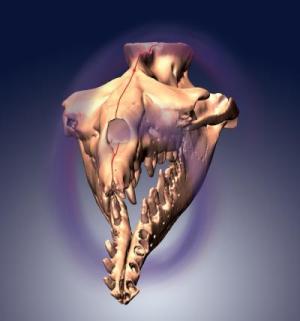
From “Ancient Whale Skulls and Directional Hearing: A Twisted Tale” (ScienceDaily, Aug. 22, 2011), we learn, re a 37 mya whale:
Skewed skulls may have helped early whales discriminate the direction of sounds in water and are not solely, as previously thought, a later adaptation related to echolocation.
How one scientist discovered this is quite interesting:
“We thought, like everybody else before us, that this might have happened during burial and fossilization,” Fahlke said. “Under pressure from sediments, fossils oftentimes deform.” To correct for the deformation, coauthor Aaron Wood, a former U-M postdoctoral researcher who is now at the University of Florida, straightened out the skull in the digital model. But when Fahlke began working with the “corrected” model, the jaws just didn’t fit together right. Frustrated, she stared at a cast of the actual skull, puzzling over the problem.
“Finally it dawned on me: Maybe archaeocete skulls really were asymmetrical,”
Mmm. Good thought that. She got hold of more skulls.
“Taken together, the six skulls deviate significantly from symmetry,” Fahlke said. “Taken individually, four of them deviate significantly.” The other two appear asymmetrical, but their measurements fall within the range of the symmetrical comparative sample.
“This shows that asymmetry existed much earlier than previously thought — before the baleen whales and toothed whales split,” Fahlke said.
Much earlier than previously thought? Dammit, that’s UD News’s line!! Thief!! Okay, okay, let’s call it convergence.
File under: Earlier than thought
File with:
200 million-year-old eel, discovered alive, predates current eel fossils
Ancient seagoing reptiles gave live birth?
